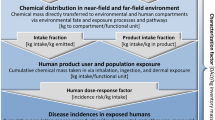Abstract
Methods for life cycle assessment of products (LCA) are most often based on the general prevention principle, as opposed to the risk minimization principle. Here, the desirability and feasibility of a combined approach are discussed, along with the conditions for elaboration in the framework of LCA methodology, and the consequences for LCA practice. A combined approach provides a separate assessment of above and below threshold pollution, offering the possibility to combat above threshold impacts with priority. Spatial differentiation in fate, exposure, and effect modelling is identified to play a central role in the implementation. The collection of region-specific data turns out to be the most elaborate requirement for the implementation in both methodology and practice. A methodological framework for the construction of characterization factors is provided. Along with spatial differentiation of existing parameters, two newly introduced spatial parameters play a key role: the sensitivity factor and the threshold factor. The practicability of the proposed procedure is illustrated by an example of its application. Providing a reasonable data availability, the development of separate LCA characterization factors for the respective assessment of pollution levels above and below environmental threshold values seems to be a feasible task that may add to LCA credibility.
Similar content being viewed by others
References
Barnthouse L, Fava J, Humphreys K, Hunt R, Laibson L, Noesen S, Owens JW, Todd J, Vigon B, Weitz K, Young J, (eds) (1997): Life-Cycle Impact Assessment: The State-of-the-Art. SETAC Pensacola Florida USA
Chapman PM, Caldwell RS, Chapman PF (1996): Warning: NOECs are Inappropriate for Regulatory Use. Letter to the Editor. Environ Toxicol Chem 15, 77–79
Guinée JB, Heijungs R, van Oers L, Wegener Sleeswijk A, Van de Meent D, Vermeire T, Rikken M, (1996): USES Uniform System for the Evaluation of Substances. Inclusion of Fate in LCA Characterisation of Toxic Releases Applying USES 1.0. Int J LCA 1, 133–138
Heijungs R, (1995): Harmonization of Methods for Impact Assessment. ESPR — Environ Sci & Pollut Res 2, 217–224
Heijungs R, Guinée JB (1994): The Flux-Pulse Problem in LCA. LCA News 4, 6–7
Huijbregts MAJ, Thissen UMJ, Guinée JB, Jager T, Kalf D, Van de Meent D, Ragas AMJ, Wegener Sleeswijk A, Reijnders L, (2000): Priority Assessment of Toxic Substances in Life Cycle Assessment. Part I: Calculation of Toxicity Potentials for 181 Substances with the Nested Multi-Media Fate Exposure and Effects Model USES-LCA. Chemosphere 41, 541–573
ILSI (1996): Human Health Impact Assessment in Life Cycle Assessment: Analysis by an Expert Panel. ILSI Health and Environmental Science Institute Washington D.C USA
ISO (2000): Environmental Management — Life Cycle Assessment — Life Cycle Impact Assessment. ISO/FDIS 14042:(E). First edition 2000-03-01. ISO 14042:2000 Geneva, Switzerland
Mackay D, (1991): Multimedia Environmental Models. The Fugacity Approach. Lewish Publishers, Chelsea Michigan, USA
Potting J, Hauschild M, Wenzel H, (1999): ‘Less is Better’ and ‘Only Above Threshold’: Two Incompatible Paradigms for Human Toxicity in Life Cycle Assessment? Int J LCA 4, 16–24
Potting J, Schöpp W, Blök K, Hauschild M, (1998): Site-Dependent Life-Cycle Impact Assessment of Acidification. Journal of Industrial Ecology 2, 63–87
Udo de Haes HA, Jolliet O, Finnveden G, Hauschild M Krewitt W, Mueller-Wenk R, (1999): Best Available Practice Regarding Impact Categories and Category Indicators in Life Cycle Impact Assessment. Background Document for the Second Working Group on Life Cycle Impact Assessment of SETAC-Europe (WIA-2). Int J LCA 4, 66–74 and 167–174
Udo de Haes HA, Owens JW (1998): Evolution and Development of the Conceptual Framework and Methodology of Life-Cycle Impact Assessment. Society of Environmental Toxicology and Chemistry, Pensacola, Florida, USA
Wania F, Mackay D (1995): A Global Distribution Model for Persistent Organic Chemicals. The Sci Total Environ 160/161,211–232
Wegener Sleeswijk A (1997): Product versus Process in Impact Assessment. Proceedings Eco Informa’97, München, pp 192–197
White P, De Smet’B, Udo de Haes HA, Heijungs R, (1995): LCA Back on Track. But is it One Track or Two? LCA News 5, 2–4
Author information
Authors and Affiliations
Corresponding author
Rights and permissions
About this article
Cite this article
Sleeswijk, A.W. General prevention and risk minimization in LCA A combined approach. Environ Sci & Pollut Res 10, 69–77 (2003). https://doi.org/10.1065/espr2001.09.090
Received:
Accepted:
Issue Date:
DOI: https://doi.org/10.1065/espr2001.09.090




